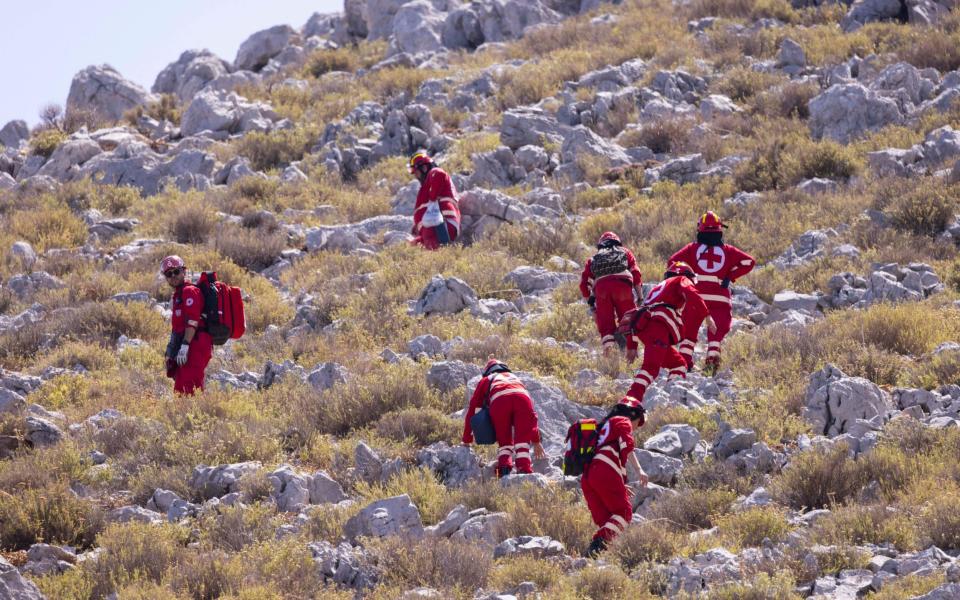For decades, the prospect of hiking along winding, thyme-scented trails on sun-baked Mediterranean islands has lured Britons and others from Europe’s frigid north.
But rising temperatures caused by global warming mean swathes of southern Europe are effectively becoming off-limits for walkers in the hottest months of the summer, experts say.
The dangers posed by extreme temperatures have been vividly illustrated this month with the deaths of several hikers, most of them in Greece.
Age appeared to be a significant factor – most were in their sixties and seventies.
Many adventure travel companies are no longer offering hiking holidays in Spain, Portugal and Greece in July and August because of the danger posed by high temperatures, particularly to elderly people.
Travel firms are having to adapt to rapidly changing climatic conditions, offering more trips in the spring and autumn and pivoting to cooler destinations in the north like Scotland and Scandinavia.

“We’ve made some significant changes to our hiking offerings in southern Europe. We’ve stopped offering hikes in July and August in Portugal, Spain and Greece.
“It has happened over the last couple of years and it is linked to the rising temperatures. The heat presented a danger,” said Hazel McGuire, general manager for Europe at Intrepid Travel.
“Scientific studies consistently show that adults older than 65 years, people with cardiopulmonary and other chronic diseases, and very young children are particularly vulnerable to the effects of heat,” The Lancet, a British medical journal, noted in a recent report.
Michael Mosley
The most high-profile case was that of Michael Mosley, the 67-year-old British doctor and health journalist who was known to millions of television viewers for his documentaries.
He died after going for a walk by himself on the island of Symi in the Aegean in temperatures that reached 38C (100F) – and his was just one of several deaths.
On Friday, a 70-year-old British man was found dead in the Spanish Pyrenees, four days after he set off on a hike.
A 74-year-old Dutch hiker was found dead on the island of Samos and earlier this week a 67-year-old German walker died while hiking near Tripiti Gorge on the rugged south coast of Crete. He had contacted his wife to say he was lost and had run out of water.
A 55-year-old American tourist died on the tiny island of Mathraki near Corfu. Another American, Albert Calibet, a 59-year-old retired policeman, went missing on a hike on the Aegean island of Amorgos and has yet to be found.
Mr Calibet had set off on a well-marked path from the north of the island to a small port called Katapola. He knew the island well and was an experienced hiker, making his disappearance something of a mystery.
“He may have chosen to take a tougher route, and perhaps overestimated his capabilities. The heat has been intense,” said Calliope Despotidi, the deputy mayor of Amorgos.
Constantina Dimoglidou, a spokeswoman for Greek police, said that hikers running into trouble is not new – it happens every year. “But this year, it seems more people became disoriented during the heatwave.”
Athens tops 43C
Greece registered its earliest recorded heatwave last week, forcing the closure of the Acropolis and some schools as the temperature rose to 43C (109F) in Athens. It is on track to be the warmest June ever recorded in Greece.
Hiking in places like Greece in the hottest months is simply no longer advisable, experts warn.
Intrepid Travel, which offers tours to destinations around the world, from Europe to Africa and the Himalaya, registered 121 more climate-related incidents affecting its clients last year than in 2022, including extreme heat, floods and wildfires.
“Climate change is having a meaningful impact on itineraries. We’re seeing a trend towards Scandinavia and cooler climates further north in Europe,” said Ms McGuire.
Shoulder season
Intrepid saw a 61 per cent increase last year in “shoulder season” bookings – the period between the peak and off-peak – in western Europe and a 29 per cent increase to southern Europe.
The company has added more holiday packages during this time to destinations such as Italy, Spain, France and Portugal so that customers can take advantage of cooler weather.
“Customers want to travel more in the spring and autumn and some of that is heat related,” said Ms McGuire.
Scorching heat is becoming more of an issue in Europe because temperatures on the continent are rising at roughly twice the global average rate, according to the World Meteorological Organisation and the EU’s climate agency, Copernicus.

In Europe, deaths linked to hot weather have risen by a third over the past 20 years.
Greece has set up a heat-related health warning system called Heat-Alarm. Launching it last year, scientists said that “the eastern Mediterranean is facing an increased occurrence of intense and long-lasting heat waves. Future climate projections indicate that such extremes will be the norm for eastern Mediterranean countries in the course of the 21st century.”
Older people more susceptible
Older people store heat in their bodies more than young people and as a result are more susceptible to heat exhaustion and heat stroke, said Christos Giannaros, one of the scientists who leads the project.
Travel patterns in Europe are dramatically shifting, said Ginny Lunn, the owner of hiking travel company WalkingWomen.
“Our busiest time is now April, before it gets too hot in places like Greece and southern Spain, and then the end of September, October and November. We’re now going to southern Spain in December – you still get wonderful blue skies.
“In the summer we are going north, to Norway, which has become very, very popular, and Scotland. These are now our biggest destinations for summer hiking. The heat is arriving earlier. You just have to rethink how you plan your holiday.”
Most of WalkingWomen’s clients are over 50 and they need to be particularly aware of the dangers posed by the heat.
“We advise clients to carry two litres of water, to wear a hat, to choose shady routes by water if possible. We use local guides who are highly experienced so they can adapt to changing weather conditions,” said Ms Lunn.
School holidays
While empty nesters and retirees can avoid July and August and instead opt to go on holiday in the spring or autumn, families with school-age children are bound to the school holidays.
For them, the advice is to change destination – to avoid the most torrid parts of southern Europe in high summer and opt for cooler places. Last year, research by InsureandGo, a travel insurance company, found that 71 per cent of Britons believe that holiday destinations in the Mediterranean, such as Spain, Greece, Cyprus and Turkey, will be too hot to visit within the next five years.
“We have always tried to encourage our clients to go off-season but climate has put more emphasis on that. Why go to Lisbon in August when you will suffer in the heat?” said Justin Wateridge, managing director of Steppes Travel, a company that arranges luxury holidays around the world, from spotting snow leopards in India to tracking wolves in Italy’s Apennine mountains.
‘It’s about being savvy’
“If a client phones up and says they want to climb Mt Toubkal [the highest peak in Morocco] in July, we would suggest they go at another time when it is less hot. Suppliers on the ground are definitely offering more availability during shoulder seasons like spring and autumn. It’s about being savvy about destinations.”
A report released by the EU last year about the impact of climate change on tourism concluded that “coastal regions in northern Europe are projected to register substantial increase in demand during summer and early autumn months while…southern coastal regions will strongly lose summer tourist flows.
“Tourism demand is projected to increase in the spring and autumn shoulder seasons.”
Avoiding the increasingly unbearable heat of southern Europe in the high summer is not just a matter of safety. “Hiking when it’s 40C is not much fun,” said Ms McGuire. “We have to be mindful of people’s enjoyment.”
Broaden your horizons with award-winning British journalism. Try The Telegraph free for 3 months with unlimited access to our award-winning website, exclusive app, money-saving offers and more.
